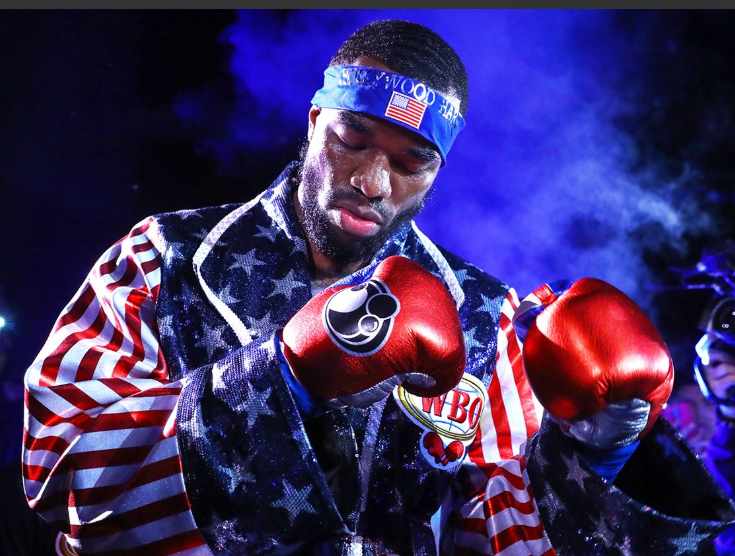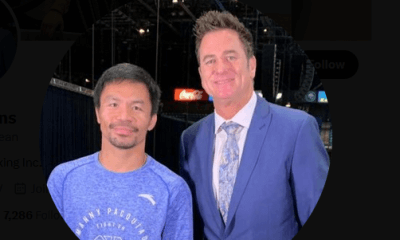Featured Articles
Jesse Hart Wants Revenge vs. Joe Smith Jr., But Served Piping Hot

Charles Maurice de Talleyrand-Perigord, a French diplomat in the 1800s, is widely credited as the originator of the saying that “revenge is a dish best served cold,” which is to say that retribution is most effectively achieved when the would-be avenger’s immediate, inflamed passions have been tempered into steely, calculating resolve.
It has been a little more than three years since Father Time, with an assist from Joe Smith Jr., finally caught up with the great Bernard Hopkins, who suffered the only loss inside the distance in his 28-year professional career when he was knocked out in the eighth round by Smith on Dec. 17, 2017, at the Forum in Inglewood, Calif. Even though B-Hop was then just 29 days shy of his 53rd birthday, and Smith, a construction worker from Long Island, N.Y., was, at 28, young enough to be the old master’s son, a longtime fan of Hopkins’ was personally offended when Smith had the temerity to take some verbal swipes at the vanquished legend.
That fan, a native Philadelphian as is Hopkins, is Jesse Hart (29-2, 21 KOs), who squares off against Smith (24-3, 20 KOs) in the scheduled 10-round light heavyweight main event Saturday night in the Mark G. Etess Arena of Atlantic City’s Hard Rock Hotel & Casino. The bout will be televised by ESPN.
Even without Hart’s seemingly heartfelt revenge motive to stir the pot, this matchup of the self-appointed vindicator of Hopkins’ foiled fistic farewell, a two-time world title challenger as a super middleweight, and Smith, whose resume includes not only that signature conquest of Hopkins but a shocking, first-round stoppage of highly regarded Andrzej Fonfara on June 18, 2016, has implications within the 175-pound weight class.
The 30-year-old Hart, who is promoted by Top Rank and will be fighting for only the second time as a light heavyweight, nonetheless is ranked No. 3 in that division by the WBO, No. 4 by the WBA, No. 8 by the WBC and No. 10 by the IBF. An impressive victory over Smith, also 30, no doubt would enhance his credentials for another bid for a world title, while Smith, loser of two of his last three ring appearances, one by unanimous decision to WBA light heavy champ Dmitry Bivol, is hoping an upset of Hart will again vault him back into the ratings.
But, to Hart, those are details that can and will be worked out later. This fight, he insists, is personal. He might not really know Smith enough to dislike him, but he does know that Smith defeated and then dissed Hopkins, which to Hart, son of another Philly boxing legend, middleweight knockout artist Eugene “Cyclone” Hart, is unforgivable.
At a press conference in Philadelphia to hype the fight, Hart turned toward Smith and explained why he so badly needed to put a whipping on him.
“You didn’t hurt just me, you hurt my whole city,” Hart said of Smith’s demonstration that not even Hopkins is immune to the natural laws of diminishing returns. “Philadelphia is pressuring me about this fight. I keep hearing, now that I’m a light heavyweight, `You gotta get Joe, you gotta get some payback.’ That’s my motivation. That’s my mission.”
Smith said his motivation, his mission, is to again “get my face out there,” to remind everyone that he is still around and capable of restoring some of his lost prestige. But he admitted that he is aware that Hart holds him responsible for some sort of affront to Philadelphia as a whole and to one of its most acclaimed boxing icons in particular.
“I know Jesse Hart’s coming to fight after what I did to his mentor, Bernard Hopkins,” Smith continued. “I know how he feels about it. He’s holding a grudge.
“So I know he’s looking forward to coming in there and possibly taking me out, but I’m going in there to do the same thing to him.”
It would be reasonable to believe that Hart’s expressions of outrage are feigned, possible mind games to mentally discombobulate Smith, which was something that a prime Bernard Hopkins could do about as well as anyone. Cynics might even suggest that it is all just window dressing, a false injection of drama to raise the stakes and create spectator interest. It wouldn’t be the first time that one or both fighters slung invective at each other, then hugged after the final bell and admitted that there never really was any bad blood between them.
Hart, however, insists that what he feels is real. There is a score to be settled, and Hart wants to painfully extract what he believes Smith owes for his impudence of three years ago.
“This ain’t got nothing to do with business or purses or who I’m going to fight later on,” he told a couple of Philadelphia reporters whom he has known for some time. “I’m going in there to do some real damage. I got to get Joe.
“Look, y’all know how close I am to Bernard Hopkins. I’ve been talking to Bernard since I was seven years old, back when Bouie Fisher was training him. Bouie used to train my dad when my dad was 13. Bouie would put Bernard on the phone with my dad, and my dad would give him advice. Then he’d hand the phone to me and say, `Here, talk to Bernard.’
“I watched most of Bernard’s fights when I was coming up. When he beat Felix Trinidad he was, like, the hero of the whole city of Philadelphia. An instant icon. That was the biggest day of my life, to be up there on that stage with him when he was honored at the Lucian Blackwell thing (a ceremony hosted by the now-deceased Philly city councilman).”
The bond between Hopkins and Hart remains as strong as ever. When Hart looks at Smith, rightly or wrongly he sees a thief who stole a bit of his childhood and laughed about it.
“Bernard made a promise to his deceased mother (that he’d retire at 40),” Hart recalled. “He made that promise to his hometown and to his daughter. But because of the simple fact that he could still fight, he kept fighting. If it wasn’t for that loss (to Smith), he’d probably still be fighting now. It took that loss to make him stop.
“But when he lost that fight, it hurt that little boy who idolized him and still does. When he came back (from California), he told me, `I’m sorry, Jesse. I went in there and did my best. It just wasn’t my night.’ He hugged me when he saw tears in my eyes. I felt like I lost. The little boy inside me was crying.
“That subject is still sensitive to me. The only way to make it right is for me to do (Smith) in. When this fight was made, I talked to Bernard and I said, `It’s going to be all right. I got Joe Smith.’”
Check out more boxing news on video at The Boxing Channel
To comment on this story in The Fight Forum CLICK HERE
-

 Featured Articles3 weeks ago
Featured Articles3 weeks agoVito Mielnicki Jr Whitewashes Kamil Gardzielik Before the Home Folks in Newark
-

 Featured Articles4 days ago
Featured Articles4 days agoResults and Recaps from New York Where Taylor Edged Serrano Once Again
-

 Featured Articles1 week ago
Featured Articles1 week agoFrom a Sympathetic Figure to a Pariah: The Travails of Julio Cesar Chavez Jr
-

 Featured Articles3 days ago
Featured Articles3 days agoResults and Recaps from NYC where Hamzah Sheeraz was Spectacular
-

 Featured Articles4 weeks ago
Featured Articles4 weeks agoCatching Up with Clay Moyle Who Talks About His Massive Collection of Boxing Books
-

 Featured Articles1 week ago
Featured Articles1 week agoCatterall vs Eubank Ends Prematurely; Catterall Wins a Technical Decision
-

 Featured Articles4 days ago
Featured Articles4 days agoPhiladelphia Welterweight Gil Turner, a Phenom, Now Rests in an Unmarked Grave
-

 Featured Articles3 weeks ago
Featured Articles3 weeks agoMore Medals for Hawaii’s Patricio Family at the USA Boxing Summer Festival



















